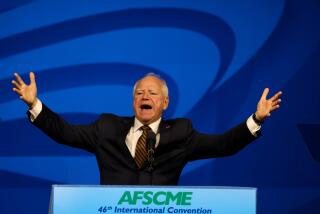Pawlenty’s fiscal claims questioned
In every speech Republican presidential hopeful Tim Pawlenty gives these days, he touts his fiscal record during his eight years as governor of Minnesota. “I drew a line in the sand,” he likes to say, bragging that he vetoed every tax increase and demanded that state government officials “live within our means just like families, just like businesses, just like everybody else.”
A close look at Pawlenty’s record in Minnesota, and conversations with former Republican allies in the state, suggest that the former governor’s tough rhetoric does not match Minnesota’s reality.
Pawlenty did veto almost all proposed tax increases, apart from one on cigarettes labeled a “health impact fee.” He curbed the rate of growth in state spending -- though not growth overall.
But to do that, he relied on money from the federal stimulus -- a program he has decried as wasteful -- and other one-time fixes. He postponed school and other obligations, leading to hikes in local property taxes and strains on school districts as burdens shifted downward.
Most strikingly, he left the state with a $5-billion projected deficit, one of the highest in the nation as a percentage of the state’s general fund, only slightly trailing California’s massive gap.
Pawlenty blames the deficit on Democrats in the Legislature who he said ignored his requests for permanent budget trims and insisted on continued spending. But Pawlenty’s critics fault him for what one called “sleight-of-hand budgeting” and a failure to work with a Democratic-controlled Legislature before he left office in 2011.
“Tim Pawlenty’s philosophy of fiscal management can be summarized as ‘kick the can down the road,’ ” said former Minnesota Gov. Arne Carlson, a Republican, referring to what he calls Pawlenty’s pattern of “engaging in heavy borrowings and shifting costs to local governments, including school districts, while not confronting the state’s serious challenges.”
Carlson, who endorsed Pawlenty when he first ran for governor in 2002 and backed Barack Obama for president in 2008, represents an older and now much-maligned brand of moderate Republicanism once dominant in Minnesota. He and like-minded critics take issue not only with Pawlenty’s abilities as an economic steward, but also with the core of his governing philosophy: that his approach of limiting taxes and spending would stimulate economic growth.
Even some of the ascendant conservative Republicans -- those who worked closely with Pawlenty and share his philosophy -- offer criticism or muted praise. They are frustrated with him for different reasons, citing his support for the tax increase on cigarettes.
“ ‘Health impact fee’ was a euphemism. It was a tax,” said Jason Lewis, a conservative Minneapolis-based talk radio host, who says he has a “love/hate” relationship with the former governor. He lauded Pawlenty’s political skills but lamented what he said were moderate positions Pawlenty had taken through the years.
Pawlenty reflected that frustration in an interview.
“Forty-nine out of 50 states have a budget deficit,” he said. “So there is nothing out of bounds or aberrational about Minnesota’s situation.”
As a Republican governor in a moderate state, Pawlenty had to operate delicately, according to those who watched him. Dane Smith, who leads a self-described progressive think tank in the Twin Cities, lauded Pawlenty’s skill at “taking the snarl out” of an obstinately conservative agenda.
“He’s very savvy about how to deliver a conservative message to an essentially skeptical center-left audience, which is what he had in Minnesota,” Smith said.
Still, Pawlenty’s successor as governor -- Democrat Mark Dayton -- won despite last year’s Republican tide by campaigning against Pawlenty’s approach, even promising to increase taxes and spending.
In his inaugural State of the State address in February, Dayton charged that Pawlenty left the state “with a horrendous fiscal mess, a decade of economic decline and state agencies poorly managed.”
Pawlenty contended that he turned around 50 years of a liberal political culture in Minnesota by setting priorities. He wanted to cut bloated government but preserve the state’s reputation in education, healthcare and public safety. But his emphasis on cost-cutting led to tough decisions.
In 2008, after the deadly collapse of the I-35W bridge in the Twin Cities, he vetoed a transportation spending bill that would have provided $600 million for other bridges deemed deficient. The Legislature overrode Pawlenty’s decision.
Pawlenty oversaw dramatic reductions in higher-education funding and refused to spend more on early childhood programs. He allowed a slight increase in K-12 education, not accounting for inflation. In doing so, he shifted costs to local districts.
Conservatives generally praise his bold use of a little-known Minnesota provision that allows governors to cut already-appropriated funds if necessary to balance the budget.
He used the provision -- known as “unallotment” -- to trim spending in key state programs in 2010, including one that provided healthcare to working-class and impoverished adults.
Pawlenty speaks with pride of his unilateral actions -- but they were criticized as an overreach even by the chief justice of the Minnesota Supreme Court, a Pawlenty appointee, who wrote the majority opinion ruling them illegal.
Minnesota continues to rank well above average in many indices of public welfare and economic performance. But other data show the state has lost its economic edge relative to other states.
“The last nine years reversed a roughly 40-year trend of Minnesota getting better and better,” said Louis Johnston, an economist at the College of St. Benedict and St. John’s University in Minnesota who is working on a book about the evolution of Minnesota’s economy since 1850. He found a continuous economic expansion for Minnesota relative to other states until the year after Pawlenty was elected. “Starting in 2003, the rest of the country grows faster than Minnesota,” he said.
Arthur J. Rolnick, a former senior vice president for the Minneapolis Federal Reserve Bank and now a senior fellow at the University of Minnesota, applauded the former governor’s effort to trim the size of government but criticized “his failure to invest in human capital” -- education, early childhood development and job training -- which he credits for Minnesota’s economic growth in the past.
“We got sidetracked in a number of ways,” he said. “It’s a disturbing sign from an economic and moral point of view.”
Pawlenty energetically disputed such criticism, saying the remarks sprang from the entrenched political culture in his home state. He kicked back at those who called for a return to the time in the 1970s when the state’s educational investment and economic performance were referred to as the “Minnesota miracle.”
“People say, ‘We need to get back to those days.’ No we don’t!” Pawlenty said, his voice rising.
”... I say no, we are not going back. We can’t go back there. It’s what got us in trouble.”
--
More to Read
Sign up for Essential California
The most important California stories and recommendations in your inbox every morning.
You may occasionally receive promotional content from the Los Angeles Times.











